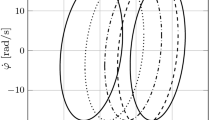Abstract
A biomechanical model is devised to analyze the motion of the human torso and estimate the load on the lumbar spine, the contraction forces in the trunk muscles, and the sensory signals between the muscle and the nervous system. A state space formulation of three-dimensional (3D) equations of motion of the human torso is presented with muscle forces as input to the system. At least 3 pairs of skeletal muscles are considered to be necessary for 3D motion of human torso. Functional anatomy of these major muscles of the human trunk are discussed. These muscles as well as their feedback and feedforward sensory paths are modeled by linear viscoelastic components and force generators. Stability of the torso with three pairs of muscles is studied both with muscle spindles inactive (open loop) and active (closed loop). Voluntary point-to-point motion of the torso in three-dimensional space is simulated on a digital computer, employing a dynamic controller, where feedback gains are tuned (programmed) by higher centers of nervous system.
Similar content being viewed by others
References
Bejjani, F.J.; Grass, C.M.; Pugh, J.W. Model for static lifting: Relationship of loads on the spine and the knee. J. of Biomechanics 17:281–286; 1984.
Belytsohko, T.B.; Andriacchi, T.P.; Shultz, A.B.; Galante, J.O. Analog studies of forces in the human spine: Computational techniques. J. Biomechanics 6:361–371; 1973.
Floyd, W.F.; Silver, P.H.S. Electromyography study of patterns of activity of the anterior abdominal wall muscles in man. J. Anatomy 84:132–145; 1950.
Goel, V.K.; Clark, C.R.; McGowan, D.; Goyal, S. An In-vitro study of the kinematics of the normal, injured and stabilized cervical spine. J. of Biomechanics 17:363–376; 1984.
Gottlieb, G.L.; Agarwal, G.C.; Startk, L. Studies in postural control systems part II; A muscle spindle model. IEEE Trans. on Systems, Man and Cybernetics, 6:127–132; 1970.
Gunnar, B.J.; Schultz, A.B.; Ortngren, R. Trunk muscle forces during desk work. Ergonomics 29: 1113–1127; 1986.
Hemami, H.; Katbab, A. Constrained inverted pendulum model for evaluating upright postural stability. J. Dynamic Systems, Measurement, and Control 104:343–349; 1982.
Hogan, N. Adaptive control of mechanical impedance by coactivation of antagonist muscles. IEEE Trans. on Automatic Control 29:681–690; 1984.
Inbar, G.F.; Pinchas, J.J. Analysis of a model of the triceps surae muscle reflex control system. IEEE Trans. on Systems, Man, and Cybernetics 1:25; 1976.
Inbar, G.F.; Yafe, A. Parameter and signal adaptation in the stretch reflex loop. Progress in Brain Research 44; 1976.
Katbab, A.; Hemami, H. Role of gain programming in the voluntary movement of the human forearm. Medical & Biological Engineering & Computing. 23:230–236; 1985.
Kendall, H.O.; Kendall, F.B.; Wadsworth, G.E.Muscles testing and function, 2nd Ed. Baltimore: The Williams and Wilkins Co.; 1979.
Mathews, P.B.C.; Stein, R.B. The sensitivity of muscle spindle afferents to small sinusoidal changes of length. J. Physiol. 200:723–743; 1969.
Morris, J.M., et al. Role of the trunk in stability of the spine. J. of Bone and Joint Surgery 43-A: 327–351; 1961.
Panjabi, M.M., et al. A technique for measurement and description of three-dimensional six degree of freedom motion of a body joint with an application to the human spine. J. of Biomechanics 14: 447–460; 1981.
Panjabi, M.M.; Krag, M.H.; Goel, V.K. Physiologic strains in the lumbar spinal ligaments, an invitro biomechanical study. Spine 7:192–203; 1982.
Rash, P.J.; Burke, P.K. Kinesiology and applied anatomy. Philadelphia: Lea Febiger, 5th Ed.; 1978.
Rubins, D.K. The human figure: An anatomy for artists. New York: Viking Press; 1963.
Schultz, A.B.; Anderson, G.B.J. Analysis of loads on the lumbar spine. Spine 6:76–82; 1981.
Schultz, A.B., et al. Loads on the lumbar spine. J. of Bone and Joint Surgery 64-A:713–720; 1982.
Schultz, A.B., et al. Analysis and measurement of lumbar trunk loads in tasks involving bends and twists. Biomechanics 15:669–675; 1982.
Schultz, A.B., et al. Analysis and quantitative myoelectric measurements of loads on the lumbar spine when holding weights in standing postures. Spine 7:391–397; 1982.
Schultz, A.B.; Haderspeck, K.; Warwick, D.; Portillo, D. Use of lumbar trunk muscles in isometric performance of mechanically complex standing tasks. J. of Orthopedic Research 1:77–91; 1983.
Zheng, Y.; Hemami, H. Computation of multibody systems dynamics by a multiprocessor scheme. IEEE Trans. on Syst., Man, and Cybernetics 16:102–110; 1986.
Author information
Authors and Affiliations
Rights and permissions
About this article
Cite this article
Katbab, A. Analysis of human torso motion with muscle actuators. Ann Biomed Eng 17, 75–91 (1989). https://doi.org/10.1007/BF02364274
Received:
Revised:
Issue Date:
DOI: https://doi.org/10.1007/BF02364274




